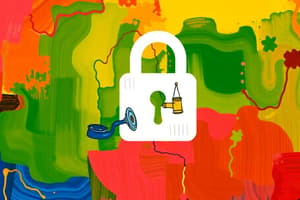Podcast
Questions and Answers
Which statement accurately describes the relationship between precision/vagueness and broadness/narrowness in legal rules?
Which statement accurately describes the relationship between precision/vagueness and broadness/narrowness in legal rules?
- The precision or vagueness of a legal rule has no effect on its range of application.
- Precise rules can have a broad range of application, and vague standards can have a narrow range of application. (correct)
- Precise rules always have a narrow range of application, while vague standards always have a broad range.
- Broad rules are always precise and narrow rules are generally vague.
Why might it be beneficial for laws regulating technology to use vague concepts?
Why might it be beneficial for laws regulating technology to use vague concepts?
- To make the laws easier for the average person to understand and therefore less precise.
- To limit the scope of the law to only current technologies.
- To ensure that all technologies are explicitly named in the law.
- To provide flexibility for the law to adapt to future technological developments. (correct)
What is the key difference between a 'rule' and a 'standard' according to the text in terms of precision and vagueness?
What is the key difference between a 'rule' and a 'standard' according to the text in terms of precision and vagueness?
- Rules are generally precise, while standards are more vague. (correct)
- Rules and standards both have general applications and either may be precise or vague.
- Rules usually have a narrower range of application compared to standards.
- Rules are vague, focusing on individual cases, while standards are precise, focusing on general situations.
If a law about 'vehicles' is considered to have a broad range of application, what would most likely have a narrower range of application?
If a law about 'vehicles' is considered to have a broad range of application, what would most likely have a narrower range of application?
Which of the following best describes the distinction between precision/vagueness and broadness/narrowness?
Which of the following best describes the distinction between precision/vagueness and broadness/narrowness?
What is the central focus that distinguishes Law 2.0 from earlier legal frameworks?
What is the central focus that distinguishes Law 2.0 from earlier legal frameworks?
Which approach does Law 2.0 primarily utilize in addressing regulatory concerns?
Which approach does Law 2.0 primarily utilize in addressing regulatory concerns?
Which of these is a critique of Law 2.0?
Which of these is a critique of Law 2.0?
How does Law 3.0 differ from Law 2.0 in achieving compliance?
How does Law 3.0 differ from Law 2.0 in achieving compliance?
What language shift is characteristic of Law 3.0 compared to normative legal language?
What language shift is characteristic of Law 3.0 compared to normative legal language?
According to legal realists, how do lawyers and judges primarily reach their decisions?
According to legal realists, how do lawyers and judges primarily reach their decisions?
What is a core criticism of Law 1.0 by legal realists?
What is a core criticism of Law 1.0 by legal realists?
What is New Public Management's (NPM) core criticism of governments?
What is New Public Management's (NPM) core criticism of governments?
According to Brownsword, what is a significant flaw in Law 1.0?
According to Brownsword, what is a significant flaw in Law 1.0?
What type of rules does NPM emphasize, in contrast to merely guiding behavior?
What type of rules does NPM emphasize, in contrast to merely guiding behavior?
What is a central focus of Law 2.0?
What is a central focus of Law 2.0?
What is a key characteristic of Legal Reasoning 2.0?
What is a key characteristic of Legal Reasoning 2.0?
In contrast to Law 1.0, what does Law 2.0 emphasize?
In contrast to Law 1.0, what does Law 2.0 emphasize?
What is the primary function of 'open texture' in legal language?
What is the primary function of 'open texture' in legal language?
How does legal language balance precision and flexibility?
How does legal language balance precision and flexibility?
According to the differences between vagueness and open texture given in the text, which statement is correct?
According to the differences between vagueness and open texture given in the text, which statement is correct?
What is a major critique of 'textualism' as a method of legal interpretation?
What is a major critique of 'textualism' as a method of legal interpretation?
How does 'textualism' claim to achieve objectivity in legal interpretation?
How does 'textualism' claim to achieve objectivity in legal interpretation?
What does the example of the interpretation of 'liberty' in the 14th Amendment illustrate?
What does the example of the interpretation of 'liberty' in the 14th Amendment illustrate?
What is one way that judges maintain 'choice' even when interpreting laws according to the text?
What is one way that judges maintain 'choice' even when interpreting laws according to the text?
What is the trade-off created by the balance between precision and flexibility in legal language?
What is the trade-off created by the balance between precision and flexibility in legal language?
According to Fuller's eight demands on legislation derived from the King Rex experiment, which of the following is NOT a characteristic of a valid rule?
According to Fuller's eight demands on legislation derived from the King Rex experiment, which of the following is NOT a characteristic of a valid rule?
Which of Fuller's demands addresses the issue of having conflicting legal requirements?
Which of Fuller's demands addresses the issue of having conflicting legal requirements?
What is identified as a potential issue with standards, as opposed to rules, according to the text?
What is identified as a potential issue with standards, as opposed to rules, according to the text?
What is the main distinction between aspirational norms and result-prescribing norms concerning their specificity?
What is the main distinction between aspirational norms and result-prescribing norms concerning their specificity?
Which term best describes a norm that sets a broad ideal, such as 'ensure safety', without outlining specific actions?
Which term best describes a norm that sets a broad ideal, such as 'ensure safety', without outlining specific actions?
How do result-prescribing norms differ from aspirational norms in their approach to behavior?
How do result-prescribing norms differ from aspirational norms in their approach to behavior?
Where are aspirational norms more likely to originate, compared to result-prescribing norms?
Where are aspirational norms more likely to originate, compared to result-prescribing norms?
Which of the following best describes the connection between aspirational and result-prescribing norms?
Which of the following best describes the connection between aspirational and result-prescribing norms?
Which critique suggests that the traditional view of judges mechanically applying laws is overly simplistic?
Which critique suggests that the traditional view of judges mechanically applying laws is overly simplistic?
What is considered an authoritative source of law in practical authority?
What is considered an authoritative source of law in practical authority?
What does the 'noble dream' critique suggest about supreme court decisions?
What does the 'noble dream' critique suggest about supreme court decisions?
How do statutes compare to precedents according to the content?
How do statutes compare to precedents according to the content?
What is the primary focus of legal reasoning as mentioned in the content?
What is the primary focus of legal reasoning as mentioned in the content?
What distinguishes practical authority from theoretical authority?
What distinguishes practical authority from theoretical authority?
Which statement correctly describes the role of rules in legal reasoning?
Which statement correctly describes the role of rules in legal reasoning?
What is a common misconception about the significance of statutes in common law systems?
What is a common misconception about the significance of statutes in common law systems?
Flashcards
Legal realists criticize Law 1.0
Legal realists criticize Law 1.0
Legal realists criticize traditional law (Law 1.0) by arguing that lawyers and judges often prioritize desired outcomes over following the law strictly. They claim that judges cherry-pick rules to justify their decisions, rather than applying the law consistently.
Critique of Law 1.0 by NPM
Critique of Law 1.0 by NPM
New Public Management (NPM) criticizes traditional government as inefficient, bureaucratic, and expensive. It advocates for running governments like businesses, focusing on outcomes and efficiency rather than rigid processes.
Brownsword's Critique of Law 1.0
Brownsword's Critique of Law 1.0
Brownsword's critique of Law 1.0 centers around its inability to adapt to rapid societal and technological changes. He argues for a move away from rigid rules and toward more flexible, goal-oriented approaches that can address evolving needs.
Key Feature of Law 2.0
Key Feature of Law 2.0
Signup and view all the flashcards
Key Feature of Legal Reasoning 2.0
Key Feature of Legal Reasoning 2.0
Signup and view all the flashcards
Shift in Legal Reasoning 2.0
Shift in Legal Reasoning 2.0
Signup and view all the flashcards
Targeted Regulations in Law 2.0
Targeted Regulations in Law 2.0
Signup and view all the flashcards
Policy Objectives in Legal Reasoning 2.0
Policy Objectives in Legal Reasoning 2.0
Signup and view all the flashcards
Precise Legal Rules
Precise Legal Rules
Signup and view all the flashcards
Vague Legal Standards
Vague Legal Standards
Signup and view all the flashcards
Range of Application
Range of Application
Signup and view all the flashcards
Vague Concepts & Technology
Vague Concepts & Technology
Signup and view all the flashcards
Fuller's Eight Demands
Fuller's Eight Demands
Signup and view all the flashcards
Textualism
Textualism
Signup and view all the flashcards
Vagueness
Vagueness
Signup and view all the flashcards
Open Texture
Open Texture
Signup and view all the flashcards
Legal Language
Legal Language
Signup and view all the flashcards
Certainty vs. Flexibility
Certainty vs. Flexibility
Signup and view all the flashcards
Textualism and Objectivity
Textualism and Objectivity
Signup and view all the flashcards
Textualism and Context
Textualism and Context
Signup and view all the flashcards
Textualism and Interpretation
Textualism and Interpretation
Signup and view all the flashcards
What is the core principle of Law 2.0?
What is the core principle of Law 2.0?
Signup and view all the flashcards
How does Law 2.0 approach risk?
How does Law 2.0 approach risk?
Signup and view all the flashcards
What is a critique against Law 2.0?
What is a critique against Law 2.0?
Signup and view all the flashcards
How might Law 3.0 use technology?
How might Law 3.0 use technology?
Signup and view all the flashcards
How does Law 3.0 approach language?
How does Law 3.0 approach language?
Signup and view all the flashcards
Aspirational Norms
Aspirational Norms
Signup and view all the flashcards
Result-Prescribing Norms
Result-Prescribing Norms
Signup and view all the flashcards
Difference: Aspirational Norms
Difference: Aspirational Norms
Signup and view all the flashcards
Difference: Result-Prescribing Norms
Difference: Result-Prescribing Norms
Signup and view all the flashcards
Connection: Aspirational and Result-Prescribing Norms
Connection: Aspirational and Result-Prescribing Norms
Signup and view all the flashcards
Source: Aspirational Norms
Source: Aspirational Norms
Signup and view all the flashcards
Source: Result-Prescribing Norms
Source: Result-Prescribing Norms
Signup and view all the flashcards
Focus: Aspirational Norms
Focus: Aspirational Norms
Signup and view all the flashcards
Schauer's Critique of Legal Positivism
Schauer's Critique of Legal Positivism
Signup and view all the flashcards
Practical Authority
Practical Authority
Signup and view all the flashcards
Theoretical Authority
Theoretical Authority
Signup and view all the flashcards
Precedents as a Primary Source of Law
Precedents as a Primary Source of Law
Signup and view all the flashcards
The 'Noble Dream' Critique of Supreme Court Decisions
The 'Noble Dream' Critique of Supreme Court Decisions
Signup and view all the flashcards
Exclusionary Reasons in Legal Reasoning
Exclusionary Reasons in Legal Reasoning
Signup and view all the flashcards
Legal Reasoning Example: Speed Limit
Legal Reasoning Example: Speed Limit
Signup and view all the flashcards
Central Role of Rules in Legal Reasoning
Central Role of Rules in Legal Reasoning
Signup and view all the flashcards
Study Notes
General Summary of Legal Reasoning
- Legal reasoning is a process of applying legal rules and precedents to specific situations.
- It often involves weighing different factors and considering the broader context.
- Legal reasoning can be distinct from other types of reasoning, such as moral, political, or personal considerations.
- There are different approaches to legal reasoning, such as formalism and realism.
Different Types of Legal Reasoning
- Formalism: Emphasizes applying rules irrespective of context.
- This approach prioritizes consistency and predictability.
- It typically focuses on interpreting the details of the law, rather than considering broader implications.
- Realism: Acknowledges that external factors (context) play an important role in legal decisions.
- Realist legal thinkers would emphasize factors beyond laws or rules, such as a judge's personality.
- Focuses on analyzing possible outcomes rather than simply applying rules.
Relationship Between Law & Morality
- Many theorists argue about whether moral considerations should influence the interpretation of positive law (written law).
- Some argue that law should always reflect moral principles, whereas others believe that it is a separate issue.
- The separation of law and morality implies some laws can be immoral but still valid.
- This issue remains debated among legal scholars.
Hard and Easy Cases
- Easy cases: Straightforward application of established rules and precedents.
- Hard cases: Require interpretation and judgment because the relevant rule is unclear or does not readily apply to the facts.
- Hard cases often raise questions of how to balance different values and principles.
- Courts may need to consider additional external factors beyond simply applying the rules of law.
Rule vs Standard
- Rules: Precise and explicit, prescribe specific actions.
- Standards: Vague and general, leave room for discretion in application.
- Standards are often used in areas where precise rules are impractical or overly rigid.
Critiques of Law 1.0
- Inability to adapt to change: Rules can be static and inflexible, leading to difficulties in handling new technologies or emerging issues.
- Unjust outcomes: Applying rules rigidly can lead to unfair or illogical consequences.
- Inconsistent application: The application of rules can differ based on a judge's discretion, potentially leading to unequal outcomes.
Criticism of Law 2.0
- Overregulation: Could lead to an excessive number of rules and standards.
- Fragmentation: Different laws and regulations may contradict one another due to inconsistencies in the social field.
- Technocratic decision-making: Focus on technical/expert rules may lead to neglecting the broader impact of policies.
- Shift in political debate: Removing these aspects from the political debate can marginalise public opinion.
Legal Reasoning 2.0
- Goal-oriented: Focused on achieving desired outcomes instead of simply following existing rules.
- Context-dependent: Consider various factors such as technology and society to determine the appropriate response.
- Flexible: Adaptable to change and new situations.
Legal Reasoning 3.0
- Embeds rules directly into design: Design of systems to proactively ensure compliance.
- Instrumental approach: Technological solutions to prevent non-compliance.
Legal Positivism
- Sees law as a matter of social fact rather than morality.
- Emphasis on legal rules, their origins, and how they are applied.
- Doesn't necessarily concern whether a law is moral or ethical.
Legal Realism
- Focuses on the role of discretion and context in legal decisions.
- External factors and social considerations significantly shape judicial decisions.
- Judges' own values and understanding of the world affect their interpretations.
Studying That Suits You
Use AI to generate personalized quizzes and flashcards to suit your learning preferences.




